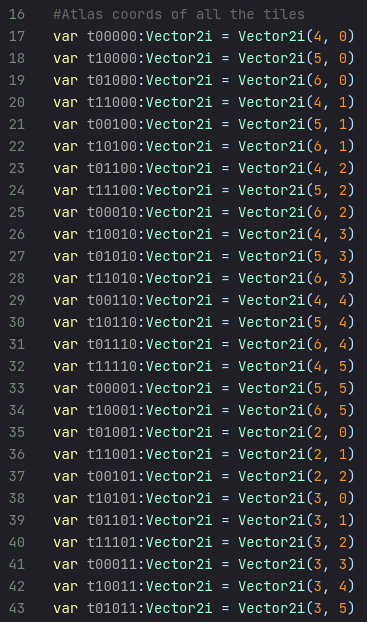
MusicPhotographyGame developmentBakingWritingBooks Hello! My name is Max!I needed to make this account for a few reasons, to share photos, for posting dev logs, and whatever else I find interesting.
49 posts
Game Development Adventures 4
Game Development Adventures 4
fixed the red squiggle
by installing a new OS
I took way to long didn't I
Well, My partner finally started working, and he made our movement script

this code , of course, allows the character to move, but it also makes the character point towards the mouse
I'm not entirely sure how this works, you'd have to ask my partner
I feel the need to show that that is all he's done while I've done this

This is the Mini-map of my code because there's too much to get in one shot
so let me see what I did this time
well as it seems I've showed you about none of my code so here we go!

Here I declare the size of the map, I'm fairly sure I've told you what the export does
I call the Tilemap
onready, I believe, just calls it before it's called
so less problems

This just lets me easily know where each tile is on the tilemap atlas
It's not actually used yet
The big dictionary is still here, I'm just not going to show it to you

Here I just initialize a couple things
We'll get to entropy in a bit

This just takes the location of a tile or cell and returns it's neighbors
there is a better way to do this that I just thought of, I'm gonna write more of this then figure that out

This is the entropy func, it's supposed to make an array/grid that contains each possible tile that could be in that cell
unfortunately i have no idea how to do this
please help me
or at least help me find a different algorithm to use
I am no quantum physicist, I'm just a high school kid
It's 9 (21) and I have a math test tomorrow
o7 cmdr
-
 evkem liked this · 2 years ago
evkem liked this · 2 years ago -
 lectronicproot liked this · 2 years ago
lectronicproot liked this · 2 years ago -
 littlebonestudios liked this · 2 years ago
littlebonestudios liked this · 2 years ago -
 compooter-blob liked this · 2 years ago
compooter-blob liked this · 2 years ago -
 doctorbllk liked this · 2 years ago
doctorbllk liked this · 2 years ago -
 cokeordie liked this · 2 years ago
cokeordie liked this · 2 years ago -
 marateleam liked this · 2 years ago
marateleam liked this · 2 years ago -
 fatepony liked this · 2 years ago
fatepony liked this · 2 years ago -
 therewillbebetterdays1717 reblogged this · 2 years ago
therewillbebetterdays1717 reblogged this · 2 years ago -
 nerdmars liked this · 2 years ago
nerdmars liked this · 2 years ago -
 musicvsartstuff reblogged this · 2 years ago
musicvsartstuff reblogged this · 2 years ago -
 musicvsartstuff liked this · 2 years ago
musicvsartstuff liked this · 2 years ago -
 xiabablog reblogged this · 2 years ago
xiabablog reblogged this · 2 years ago -
 xiabablog liked this · 2 years ago
xiabablog liked this · 2 years ago -
 no-semicolons liked this · 2 years ago
no-semicolons liked this · 2 years ago
More Posts from No-semicolons
Game Dev Adventure 1
Oh, I'm a week late aren't I!
I’m trying a new style, inspired by @the-seelie-court-official
Well, no time better than the present!
I'm changing the upload schedule to Tuesdays instead of Mondays, as Monday now conflicts with my schedule.
My friend who’s helping me make this game can be found at @whythehellnot5
The game will be open source, you can find the github repo here
You can also find a website containing my notes here
Hey! what's that, I've started using numbers instead of roman numerals! You know what that means, that means I've finally started to work on the game!
As a first order of business, I'll reveal the genre! It's going to be some sort of roguelike/roguelite
I'll need your help (because I'm indecisive) to make a few choices
And seeing as I have access to Tumblr polls, I guess i should use them
If anyone is worried that I can't submit this to my school's graduation project board, don't as I'm going to make a separate version for them
I was late for many reasons, but most importantly Godot was throwing an error that I fixed by downgrading the libx11 library
Game development III
still not much to report, starting soon, end of January.
Back in a war with my schools tech office.
“Hack the planet!”
I’ve been taking so many pictures I’ll finally be able to post some
It has come to my attention that the tumblr html sucks ass and I will now just be using rich text and screenshots
